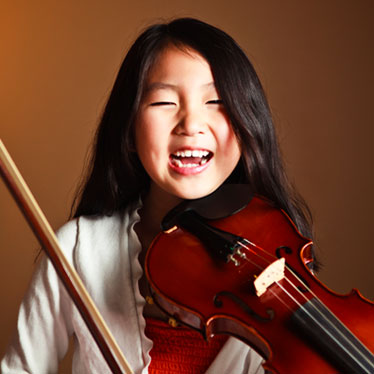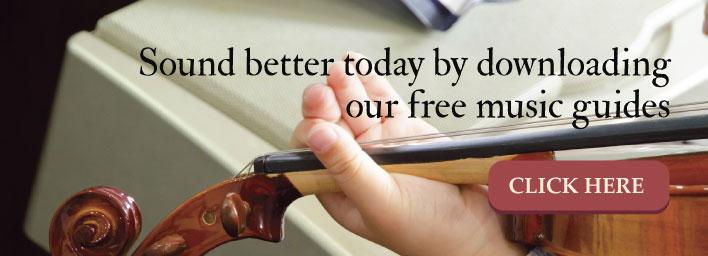6 Tips For Choosing Your First Violin

Your child wants to play the violin. Or, maybe you have decided to take up playing a musical instrument in your spare time or retirement. The benefits of music are immeasurable – from improving your focus and concentration to a sense of emotional and mental well-being. Taking that first step – buying a violin – is exciting. However, figuring out what to purchase or rent can be a big challenge. Here are some tips to make this seemingly daunting task easier
1. Craftsmanship and Quality
The materials used to create a violin – from the woods used in fabrication to the strings you choose – have a combined effect on the sounds generated. Look for solid woods (spruce, maple, and other quality woods) joined tightly, in an instrument that has good symmetry. These factors determine the quality of sound, and the better it sounds when played, the more likely a beginning student will want to continue learning.
2. Don’t Underestimate Size
Selecting the right size violin is extremely important. Adults use full-size violins, also called "4/4." But children and younger players need much smaller violins. Playing on the wrong size instrument can create serious technique issues and lead to chronic neck, back, and arm injuries. Be sure to account for age, body size, hand shape, and physical strength. If in doubt, going with a smaller size is better than playing on a violin that is too big. If you’re looking for an instrument for a child, don’t make the mistake of thinking that the child will “grow into it.”
Violin sizes will typically range from 1/16-size (15 inches in length) to a full-size 4/4 (23.5 inches in length). That's why it's best to try out different sizes before buyings to make the best choice. A correct fit can be determined when holding the instrument under the chin in a playing position, and the scroll (the decorative carved handle at the beginning of the neck) fits comfortably in the student’s palm, with the elbow slightly bent. Ask an experienced violinist or your teacher to shop with you to find the right fit.
3. Price Range and Quality
Ideally, you will want to obtain the best quality violin for the lowest possible price. A quality beginner violin can start at about $600, with intermediate, university-level violins at $1,500, and professional violins at several thousands of dollars. Should you spend that much on your first violin? In six months you may decide the violin is not for you. Or, your child will outgrow the smaller violin size quickly. Check here for a good indicator of quality as well as our guide for buying a violin.
4. Buy Online or In-Store?
Some first-time buying guidelines suggest not to buy online – to only buy a violin you have tried-out first in a music shop. This is great advice for intermediate and advanced players who have developed skills and preferences to test the differences between expensive violins. It is an option to research a less expensive violin kit online and develop skills and personal preferences to get a general feel for the violin. That may carry the player through the first 6 to 12 months of playing, which is a critical period when most people decide whether they will stick with the violin or not. But many cheap online violins can’t be tweaked for imporvement and aren’t very playable. Be sure to buy from an online vendor who offers a return policy so you can see if the violin fits you or your child correctly. If you go the online route, take the violin to a music shop for adjustments on a decent instrument for improved sound.
5. To Rent or Not to Rent?
Another option is to rent, but more often than not these instruments will end up costing you the same equivalent of buying a beginner violin within 12 months. However, if you are not quite sure whether the violin will suit you or your child's personal taste, renting your first violin is a great idea. If your child is very young and requires a violin less than ½ size, they will quickly outgrow the instrument. In this case, renting can be a smart solution, as well as purchasing a used violin. Check with your local instrument shops to discuss rental rates and policies.
6. Strings and Accessories
To achieve the best sound, beginners should start with perlon (a type of nylon) or synthetic core strings, if possible. Steel core strings, while being wonderful for certain genres of music, aren’t necessarily associated with the warm, rich tones of the violin. Spending a little more for these types of strings is worth it. The Alphayue strings by Thomastik-Infeld are great beginner strings – synthetic core strings at a steel core price. Moreover, the synthetic core stays in tune longer, so students can practice without having to stop to make frequent tonal adjustments.
Be sure to choose a bow that will bring out the best in the violin, and in turn, the student. Carbon composite and carbon fiber bows are great for beginners because of their combined agility and strength. And don’t forget the rosin. No rosin? No sound! And lastly, you will need a case to protect and carry your wonderful new instrument. Check out our tips for buying the perfect case here.
There are lots of violins to choose from. Take your time. Ask your teacher for suggestions. Make sure that the violin you buy is the right one for your child, or you.


